


















Botanical art
Etymology
Thelymitra from Greek 'thelys' meaning a bishop and 'mitra' meaning a headwear, hat, hence a bishop’s mitre, referring to the sometimes plumed or decorated wings of the column, which is usually produced behind and over the anther in a hood-like projection. Pauciflora from the Latin 'paucus' meaning few and 'florus' meaning flower, referring to the spike having few flowers.
Distribution and status
Found in the southern part of South Australia, from the Flinders Ranges to the lower South-east, growing in a wide variety of habitats including open forest, woodland, heathland, grassland and coastal shrubland on well-drained sandy or clay loams. Also found in Queensland, New South Wales, Victoria and Tasmania. Native. Common in South Australia. Common in the other states.
Herbarium regions: Eyre Peninsula, Northern Lofty, Murray, Southern Lofty, Kangaroo Island, South Eastern, Green Adelaide
NRM regions: Adelaide and Mount Lofty Ranges, Eyre Peninsula, Kangaroo Island, Northern and Yorke, South Australian Murray-Darling Basin, South East
AVH map: SA distribution map (external link)
Plant description
Glabrous terrestrial orchid with linear leaves to 30 cm long and 6 mm wide, erect, fleshy, dark or light green with a purplish base. Flowering spike slender, straight, green to purplish, to 50 cm long with 1-3 pale blue (less often pink or white) flowers opening tardily on warm to hot days. Flowering between September and November. Fruits are brown papery obovoid capsule to 15 mm long and 6 mm wide, ribbed.
Seed collection and propagation
Collect seeds between October and November. Collect fat capsules as they start to dry and turn brown. Pods will split and release the seeds quickly and will require monitoring. To increase the chances of collecting mature pods, it is recommended that a small breathable bag (ie. Organza bags) be used to enclose the developing capsules. Place the capsules in a container that will hold fine seeds and leave to dry for a few weeks or until the capsule split. Then carefully hold the capsule and tap it gently to release the seeds. Store the seeds with a desiccant such as dried silica beads or dry rice, in an air tight container in a cool and dry place or in liquid nitrogen.
| Location | No. of seeds (weight grams) | Number of plants | Date collected | Collection number Collection location | Date stored | % Viability | Storage temperature |
|---|---|---|---|---|---|---|---|
| BGA | 502,000 (0.396 g) | 18 | 17-Nov-2015 | TST1254 Kangaroo Island | 1-Nov-2016 | 90% | -80°C |
Number of plants: This is the number of plants from which the seeds were collected.
Collection location: The Herbarium of South Australia's region name.
% Viability: Percentage of filled healthy seeds determined by a cut test or x-ray.